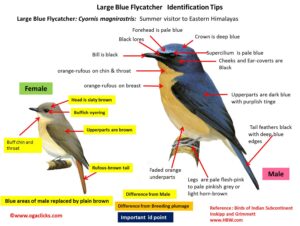
Large Blue Flycatcher Cyornis magnirostris
Etymology:
- Cyornis : Greek Word kuanos dark-blue; ornis-bird
- Magnirostris : Latin word Magnus – Large; Rostrum – Bill
Distribution in India: Summer Visitor to East Himalayas .
Description: Size of 15 cm. It is a medium-sized flycatcher, male is blue, orange and white and female is brownish with rufous rump. The male has forehead and supercilium (extending posteriorly to above ear-coverts) rather cold pale blue, lores, cheeks and most of ear-coverts are black; crown is deep blue, upperparts are dark blue with purplish tinge, flight-feathers and most of wing-coverts are blackish with purplish-blue edges, tail feathers are black with deep blue edges. The chin and throat are orange-rufous, the colour extending to rear flanks and mid-belly, with lower underparts as whitish. The iris is very dark brown; bill is black; legs are pale flesh-pink to pale pinkish grey or light horn-brown. The female is dark above, with crown slaty brown, upperparts are dark brown, rump, tail and edges of remiges strongly tinged rufous, pale buffish eyering and lores, dark slaty-brown cheek contrasting pale rufous-tinged buff chin and throat, rest of underparts much as male. The juvenile resembles female, but is darker brown with rufescent spots above, throat and breast deep buff with dark bars and scaling, belly and vent whitish with faint dusky mottling. yellowish, tail blackish. The immature resembles female.
Habitat: It is found in hills, evergreen forest, moist primary and secondary broadleaf forests, open forest; in parks and gardens on migration. It breeds at 750–1900 m. In non-breeding season, winter visitors at lower levels up to 600 m.
Food habits: It eats small invertebrates. It is usually in pairs, but generally solitary in non-breeding season. It forages in undergrowth and shaded lower levels of forest, occasionally darting from perch to seize passing insects; sits unobtrusively on perch for long periods.
Breeding habits: They breed in Jun-July.